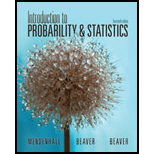
Concept explainers
(a)
To calculate the probability that more than six consumers say they have become conservative spenders.
(a)
Answer to Problem 5.82SE
The probabilities that more than six consumers say they have become conservative spenders is
Explanation of Solution
Since we are interested in the number of successes among a fixed number of independent trials with a constant probability of success, we can use the Binomial distribution.
The binomial probability is defined as,
Where
Now, the probability that more than six consumers say they have become conservative spenders implies,
Where,
Which implies,
Thus, we have,
And now,
(b)
To calculate the probability that fewer than five of those sampled have become conservative spenders.
(b)
Answer to Problem 5.82SE
The probabilities that fewer than five of those sampled have become conservative spendersis
Explanation of Solution
Since we are interested in the number of successes among a fixed number of independent trials with a constant probability of success, we can use the Binomial distribution.
The binomial probability is defined as,
Where
Now, the probability that fewer than five of those sampled have become conservative spenders implies,
Which implies,
Thus, we have,
(c)
To calculate the probability that exactly nine of those sampled have become conservative spenders.
(c)
Answer to Problem 5.82SE
The probabilities that exactly nine of thosesampled have become conservative spenders is
Explanation of Solution
Since we are interested in the number of successes among a fixed number of independent trials with a constant probability of success, we can use the Binomial distribution.
The binomial probability is defined as,
Where
Now, the probability that exactly nine of thosesampled have become conservative spenders implies,
Want to see more full solutions like this?
Chapter 5 Solutions
Introduction to Probability and Statistics
 Glencoe Algebra 1, Student Edition, 9780079039897...AlgebraISBN:9780079039897Author:CarterPublisher:McGraw Hill
Glencoe Algebra 1, Student Edition, 9780079039897...AlgebraISBN:9780079039897Author:CarterPublisher:McGraw Hill Big Ideas Math A Bridge To Success Algebra 1: Stu...AlgebraISBN:9781680331141Author:HOUGHTON MIFFLIN HARCOURTPublisher:Houghton Mifflin Harcourt
Big Ideas Math A Bridge To Success Algebra 1: Stu...AlgebraISBN:9781680331141Author:HOUGHTON MIFFLIN HARCOURTPublisher:Houghton Mifflin Harcourt Holt Mcdougal Larson Pre-algebra: Student Edition...AlgebraISBN:9780547587776Author:HOLT MCDOUGALPublisher:HOLT MCDOUGAL
Holt Mcdougal Larson Pre-algebra: Student Edition...AlgebraISBN:9780547587776Author:HOLT MCDOUGALPublisher:HOLT MCDOUGAL


